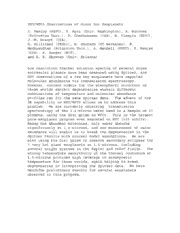
NASA Technical Reports Server (NTRS) 20110011670: HST/WFC3 Observations of Giant Hot Exoplanets PDF
Preview NASA Technical Reports Server (NTRS) 20110011670: HST/WFC3 Observations of Giant Hot Exoplanets
HST/WFC3 Observations of Giant Hot Exoplanets D. Deming (GSFC), E. Agol (Univ. Washington), A. Burrows (Princeton Univ.), D. Charbonneau (CfA) , M. Clampin (GSFC), J.-M. Desert (CfA) , R. Gilliland (STScI), H. Knutson (UC Berkeley), N. Madhusudhan (Princeton Univ.), A. Mandell (GSFC), S. Ranjan (CfA) , S. Seager (MIT), and A. P. Showman (Univ. Arizona) Low resolution thermal emission spectra of several dozen extrasolar planets have been measured using Spitzer, and HST observations of a few key exoplanets have reported molecular abundances via transmission spectroscopy. However, current models for the atmospheric structure of these worlds exhibit degeneracies wherein different combinations of temperature and molecular abundance profiles can fit the same Spitzer data. The advent of the IR capability on HST/WFC3 allows us to address this problem. We are currently obtaining transmission spectroscopy of the 1.4-micron water band in a sample of 13 planets, using the G141 grism on WFC3. This is the largest pure-exoplanet program ever executed on HST (115 orbits). Among the abundant molecules, only water absorbs significantly at 1.4-microns, and our measurement of water abundance will enable us to break the degeneracies in the Spitzer results with minimal model assumptions. We are also using the G141 grism to observe secondary eclipses for 7 very hot giant exoplanets at 1.S-microns, including several bright systems in the Kepler and CoRoT fields. The strong temperature sensitivity of the thermal continuum at 1.S-microns provides high leverage on atmospheric temperature for these worlds, again helping to break degeneracies in interpreting the Spitzer data. We here describe preliminary results for several exoplanets observed in this program.
